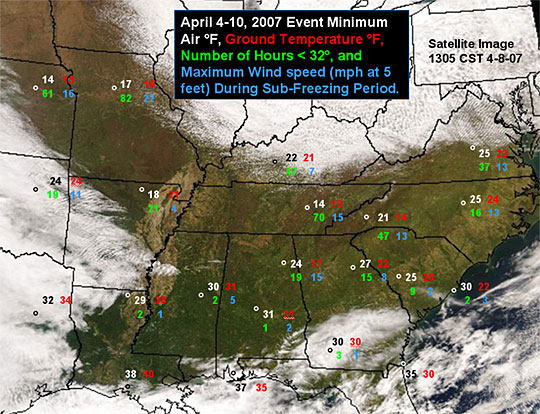How Does Your Garden Grow? – Part 2
Friday, April 11th, 2008 at 4:49 pm by Chip TaylorFiled under Degree Days | 1 Comment »
Last month (“How Does Your Garden Grow?“) I outlined my intention to show you how to use our Monarch Watch Temperature Loggers to record the temperatures in your garden and how to use the data to determine the growing degree days required for different plant species, especially milkweeds, to reach particular stages such as first shoots, first flowers, etc.
The temperatures for the winter (December-February) and March for Monarch Waystation #1 and for Lawrence are shown in Tables 1 and 2.
Table 1. Winter and March temperatures (2007-08) for Monarch Waystation #1, Lawrence, KS.
| Temperature | December | January | February | March |
|---|---|---|---|---|
| Max. Mean | 41.3 | 42.6 | 42.3 | 57.1 |
| Min. Mean | 18.7 | 15.5 | 17.0 | 28.3 |
| Mean | 28.6 | 28.2 | 28.7 | 42.5 |
Table 2. Official winter and March temperatures (2007-08) for Lawrence, KS.
| Temperature | December | January | February | March |
|---|---|---|---|---|
| Max. Mean | 39 | 37 | 38 | 53 |
| Min. Mean | 19 | 16 | 18 | 29 |
| Mean | 29 | 27 | 28 | 41 |
As I noted last month, the garden is both warmer and colder than the official weather station for Lawrence. Nevertheless, the mean temperatures are similar. How these differences will translate into growing degree days remains to be seen.
The mean temperature for Lawrence for March was 41F, quite a bit cooler than the average of 46.3F recorded from 1971-2000. In Kansas, the mean temperature for March (1895-2007) was 42.6F degrees and the temperatures this year are much lower than for 2007 in which the mean temperature was 52.2F, second only to the 54.7F recorded in 1910. As you may recall, due to the high temperatures, plant growth was advanced by as much as 12 days last spring leading to disastrous consequences when the jet stream, with temperatures in the teens, dipped into the lower Midwest and swept into the Southeast. In many areas there were 60 or more hours of freezing temperatures resulting in crop losses from Kansas to South Carolina (Figure 1). Fortunately such events are rare and less likely in years such as this one since temperatures through March have delayed plant growth to some degree.
Figure 1. Cold wave of 4-10 April 2007.

From NOAA/NESDIS/NCDC
A sample of the data from one of the data loggers in our garden is shown in Figure 2.
Figure 2. Temperatures recorded for the first 12 hours of 2 March 2008 (data logger #1).
| Date & Time | Mode | Temperature |
|---|---|---|
| 3/2/08 0:30 | F | 54.5 |
| 3/2/08 1:30 | F | 54.5 |
| 3/2/08 2:30 | F | 55.4 |
| 3/2/08 3:30 | F | 56.3 |
| 3/2/08 4:30 | F | 57.2 |
| 3/2/08 5:30 | F | 58.1 |
| 3/2/08 6:30 | F | 57.2 |
| 3/2/08 7:30 | F | 59 |
| 3/2/08 8:30 | F | 62.6 |
| 3/2/08 9:30 | F | 68.9 |
| 3/2/08 10:30 | F | 70.7 |
| 3/2/08 11:30 | F | 72.5 |
To record the number of degree days (DD) these data have to be imported into a Degree Day Workbook. The workbook calculates the DDs for each hour and summarizes the total number of monarch degree days for each day and for each month. The DD output for the first 6 days of March 2008 for Monarch Waystation #1 is shown in Figure 2. The Degree Day Workbook now found in the Monarch Watch Forums is in the process of being modified so that you can enter data for each month of the year. You will also be able to specify if you wish to calculate the degree days for either monarchs or plants. The methods are the same but the ranges of temperatures over which growth occurs are different for plants and monarchs.
Figure 2. Temperatures and monarch degree days for the first 6 days in March 2008.
| Date | Tmax | Tmin | Tmean | DD | Acc. DD |
|---|---|---|---|---|---|
| 3/1/08 | 71.6 | 27.5 | 51.58 | 5.89 | 5.89 |
| 3/2/08 | 72.5 | 33.8 | 55.03 | 6.71 | 12.60 |
| 3/3/08 | 33.8 | 20.3 | 29.04 | 0.00 | 12.60 |
| 3/4/08 | 51.8 | 14.0 | 30.65 | 0.00 | 12.60 |
| 3/5/08 | 43.7 | 23.0 | 31.66 | 0.00 | 12.60 |
| 3/6/08 | 47.3 | 16.7 | 30.35 | 0.00 | 12.60 |
There are two things to note about Figure 2: 1) the number of DDs is zero if the temperatures for the entire day are either above or below the developmental thresholds for the monarchs or plants and 2) the most important data is the accumulated DDs (Acc. DD) in the last column.
Assuming there are no freezing temperatures during the period of measurement, the number of degree days required for each of the monarchs’ life stages is: egg 45C/113F, larva 187C/369F, and pupa 120C/248F or about 720F for each generation (egg to egg). For a further discussion of degree days please see “Degree Days and Monarch Growing Season“


One Response to “How Does Your Garden Grow? – Part 2”
By nanc50 on Jun 26, 2008
I have saw several bees lately within 5 minsat a time.